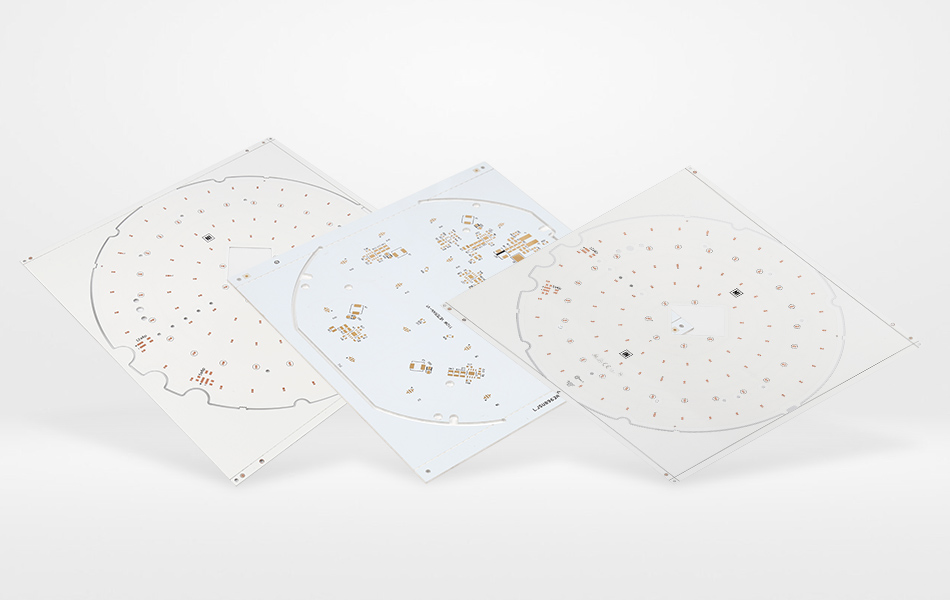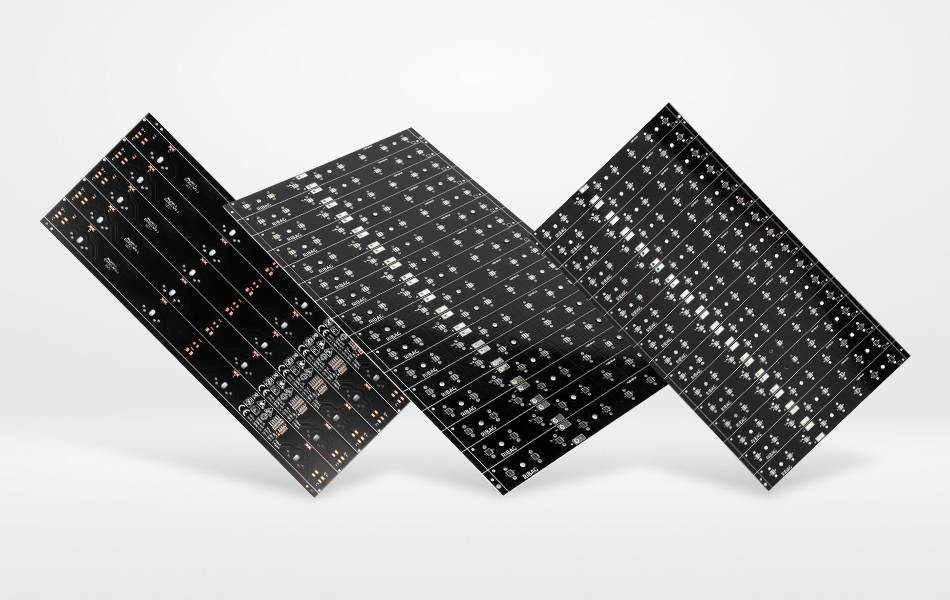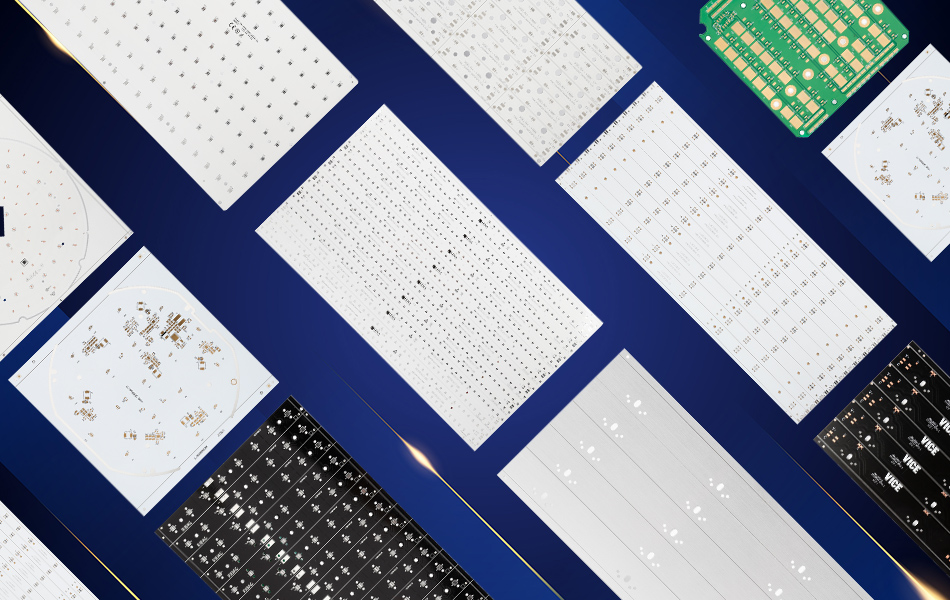-
- PCB TYPE
- PRINTED CIRCUIT BOARD PROTOTYPE ALUMINUM PRINTED CIRCUIT BOARD R&F PCB FPC HIGH FREQUENCY PCB HIGH-TG PCB HEAVY COPPER PCB HDI PCB PCB FOR LIGHTING METAL CORE PCB
time:Jul 23. 2025, 09:32:39
In the realm of modern electronics, material science serves as the cornerstone of performance and reliability. Ventec Aluminum Material PCB stands out as a testament to this principle, leveraging advanced aluminum-based materials to redefine the capabilities of printed circuit boards across industries. As electronics grow increasingly power-dense and compact, traditional PCB materials often struggle to balance thermal management, mechanical durability, and electrical performance. Ventec’s aluminum material PCBs address this challenge through meticulous material engineering, combining the inherent advantages of aluminum with proprietary dielectric and copper layer technologies. This article explores the material composition, core advantages, application ecosystems, manufacturing innovations, and future trends of Ventec Aluminum Material PCB.
Material Composition of Ventec Aluminum Material PCB
Ventec Aluminum Material PCB is engineered as a multi-layer composite, with each material component selected to synergize thermal, electrical, and mechanical properties:
Aluminum Substrate: The Foundation of Performance
At the core lies the aluminum substrate, a critical material chosen for its unique blend of thermal conductivity, lightweight properties, and structural rigidity. Ventec selects high-purity aluminum alloys optimized for thermal diffusivity, ensuring efficient heat transfer from components to the substrate. Unlike heavier metal cores or brittle ceramic substrates, this aluminum material offers a cost-effective balance, making it adaptable to applications ranging from small consumer devices to large industrial panels. Its malleability also allows for diverse form factors, from flat boards to curved or conformal designs, without compromising structural integrity.
Advanced Dielectric Materials: Bridging Insulation and Thermal Transfer
Between the aluminum substrate and copper circuit layer lies a specialized dielectric material, a key innovation in Ventec’s aluminum material PCB. Formulated from ceramic-reinforced epoxies, polyimides, or hybrid polymers, this layer serves dual roles: electrical insulation and thermal conduction. Ventec’s proprietary dielectric formulations are engineered to minimize thermal resistance while maintaining high dielectric strength, preventing electrical leakage even in high-voltage applications. These materials also exhibit stable performance across wide temperature ranges, addressing thermal expansion mismatches that can cause delamination in traditional PCBs.
High-Quality Copper Circuit Layer: Conductivity and Precision
The copper circuit layer, composed of high-purity copper foil, forms the conductive pathways for electrical signals. Ventec bonds this layer to the dielectric via advanced lamination processes, ensuring uniform adhesion and minimal interface resistance. The copper’s purity enhances electrical conductivity, while precision etching techniques (laser or chemical) create fine circuit traces with tight tolerances, supporting both low-power signal lines and high-current power paths. This combination of material quality and manufacturing precision ensures reliable signal transmission and efficient heat spreading from active components.
Together, these materials create a holistic material system where aluminum’s thermal efficiency, dielectric’s insulation capabilities, and copper’s conductivity work in harmony—setting Ventec Aluminum Material PCB apart from conventional FR-4 or non-aluminum alternatives.

Core Advantages of Ventec Aluminum Material PCB
Ventec’s aluminum material PCB delivers distinct benefits derived from its material composition, making it indispensable in diverse electronic applications:
Superior Thermal Management
Efficient Heat Dissipation: The aluminum substrate acts as a natural heat sink, rapidly distributing heat generated by components such as LEDs, power transistors, and microprocessors. This reduces thermal hotspots, a primary cause of component degradation and shortened lifespans in electronics.
Thermal Uniformity: By minimizing temperature gradients across the PCB surface, Ventec’s aluminum material ensures consistent performance of heat-sensitive components, from sensors in industrial equipment to processors in consumer devices.
Enhanced Mechanical Durability
Vibration and Impact Resistance: The aluminum substrate’s toughness and rigidity make the PCB highly resistant to vibration, shock, and physical stress—critical for automotive, aerospace, and industrial applications where equipment operates in dynamic environments.
Corrosion and Environmental Resilience: Surface treatments (anodization, conformal coatings) protect the aluminum from moisture, chemicals, and UV exposure, extending service life in outdoor applications like LED streetlights or renewable energy systems.
Balanced Electrical Performance
Electrical Insulation: The dielectric layer maintains high insulation resistance, ensuring safe operation in high-voltage applications such as power inverters and industrial controls without sacrificing thermal transfer.
Signal Integrity for General Applications: While not exclusively optimized for ultra-high frequencies, the material system supports reliable signal transmission in most consumer, automotive, and industrial electronics, with low parasitic capacitance and resistance.
Design Flexibility and Cost Efficiency
Diverse Form Factors: Ventec’s aluminum material accommodates single-layer, multi-layer, and flexible designs, enabling customization for space-constrained applications (wearables, medical devices) and large-scale systems (industrial control panels).
Cost-Effective Performance: Compared to specialized materials like ceramic PCBs, Ventec Aluminum Material PCB offers a more accessible balance of thermal, mechanical, and electrical properties, making advanced performance achievable for high-volume production.

Industry Applications of Ventec Aluminum Material PCB
Ventec Aluminum Material PCB’s material advantages drive innovation across diverse sectors, where thermal management and durability are paramount:
Automotive Electronics
Power Electronics: In electric vehicles (EVs) and hybrids, the PCB manages heat in battery management systems (BMS), motor controllers, and onboard chargers. Its aluminum substrate dissipates heat from power semiconductors, enhancing safety and energy efficiency.
Vehicle Lighting and Infotainment: LED headlights, taillights, and interior lighting systems use the PCB to maintain brightness and longevity, while its vibration resistance ensures reliability in infotainment modules and dashboard electronics.
Industrial Automation
Motor Drives and Controls: Industrial motor drives and programmable logic controllers (PLCs) rely on the PCB’s thermal efficiency to handle heat from IGBTs and power resistors, ensuring uninterrupted operation in factories and manufacturing plants.
Sensor and Actuator Modules: The material’s stability protects sensitive sensors (temperature, pressure) and actuators in harsh industrial environments, maintaining measurement accuracy and response times.
Consumer Electronics and Lighting
LED Lighting Systems: Residential, commercial, and outdoor LED fixtures use Ventec’s PCB to dissipate heat from high-output LEDs, extending lifespans and reducing maintenance costs. The aluminum substrate also enhances light uniformity in panel lights and downlights.
Consumer Devices: Smartphones, laptops, and home appliances leverage the PCB’s thermal management to prevent overheating during extended use, improving user experience and device durability.
Renewable Energy and Infrastructure
Solar and Wind Systems: Inverters and power management components in solar panels and wind turbines use the PCB to handle heat from power conversion, optimizing energy efficiency in outdoor installations.
Smart Grid Equipment: Power distribution units and smart meters rely on the material’s durability and thermal stability to operate reliably in utility infrastructure, even in extreme temperatures.

Manufacturing and Quality of Ventec Aluminum Material PCB
Ventec’s manufacturing processes are tailored to maximize the performance of its aluminum material PCB, ensuring consistency and reliability:
Material-Specific Manufacturing Techniques
Precision Lamination: The aluminum substrate, dielectric layer, and copper foil are bonded under controlled temperature and pressure to eliminate voids, ensuring efficient thermal and electrical transfer between layers.
Adaptive Etching: Laser or chemical etching is calibrated to the aluminum material’s properties, creating precise circuit patterns without damaging the substrate or compromising dielectric integrity.
Surface Treatment Optimization: Anodization or conformal coating processes are tailored to the aluminum alloy, enhancing corrosion resistance while maintaining thermal conductivity—a balance critical for outdoor and industrial applications.
Quality Assurance for Material Performance
Thermal Validation: Infrared imaging and thermal resistance testing verify heat dissipation across the aluminum substrate, ensuring consistency batch-to-batch.
Mechanical Testing: Samples undergo vibration, shock, and flex testing to validate the material’s durability under real-world stress conditions.
Electrical Insulation Checks: High-potential (hipot) tests and insulation resistance measurements confirm the dielectric layer’s performance, ensuring safe operation in high-voltage scenarios.

Future Trends in Ventec Aluminum Material PCB
Ventec continues to innovate in aluminum material PCB technology, driven by industry demands for sustainability, higher performance, and integration:
Sustainable Material Development
Recycled Aluminum Integration: Increased use of recycled aluminum in substrates reduces environmental impact, aligning with global circular economy initiatives while maintaining performance.
Eco-Friendly Dielectrics: Development of bio-based or halogen-free dielectric materials reduces toxicity, supporting greener electronics manufacturing without sacrificing thermal or electrical properties.
Advanced Material Composites
Nano-Enhanced Dielectrics: Integration of nanomaterials (boron nitride, graphene) into dielectric layers aims to further improve thermal conductivity, enabling higher power densities in compact designs.
Hybrid Substrate Designs: Combining aluminum with other materials (e.g., flexible polymers) creates multi-functional PCBs for emerging applications like wearable electronics and conformal sensors.
Application-Specific Material Tailoring
High-Temperature Formulations: Development of aluminum alloys and dielectrics with enhanced heat resistance targets extreme-environment applications, such as aerospace electronics and high-power industrial drives.
Lightweight Optimizations: Thinner aluminum substrates with maintained rigidity cater to weight-sensitive applications like drones, electric vehicles, and portable medical devices.

Conclusion
Ventec Aluminum Material PCB represents a fusion of material science and engineering innovation, offering a versatile solution for modern electronics. By leveraging aluminum’s thermal efficiency, dielectric insulation, and copper conductivity, it addresses the core challenges of heat management, durability, and performance across industries. From automotive and industrial systems to consumer devices and renewable energy equipment, Ventec’s aluminum material PCB provides a reliable foundation for innovation. As sustainability and performance demands grow, Ventec’s commitment to material advancement ensures its aluminum PCB technology will remain a cornerstone of electronic design, enabling the next generation of efficient, durable, and adaptable electronics.
Keywords: Ventec Aluminum Material PCB, aluminum substrate PCB, thermal management PCB, industrial PCB materials, sustainable electronics, PCB material innovation.
This article delivers a comprehensive, material-focused overview of Ventec Aluminum Material PCB, emphasizing its unique composition, advantages, and applications while ensuring originality and alignment with SEO best practices.

Got project ready to assembly? Contact us: info@apollopcb.com



We're not around but we still want to hear from you! Leave us a note:

Leave Message to APOLLOPCB
